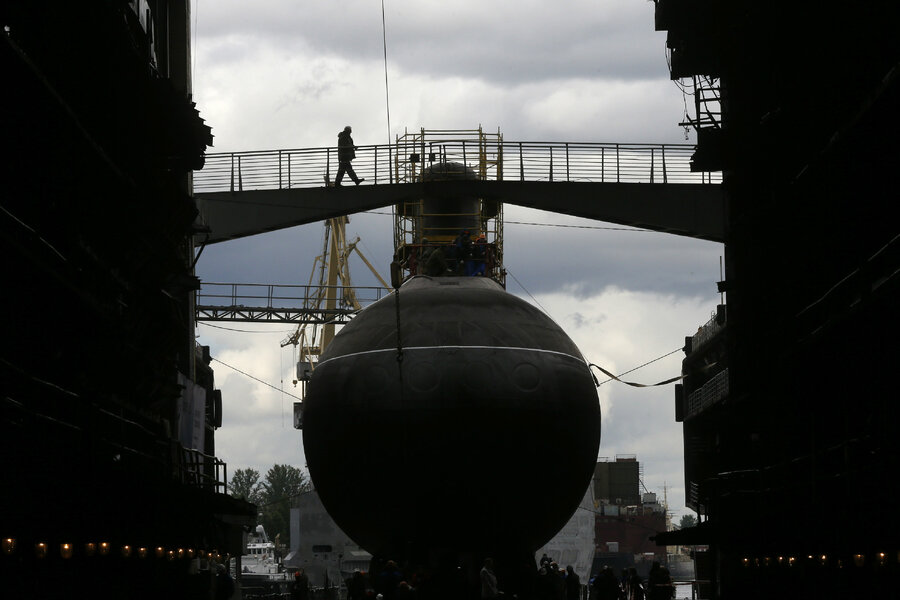Why the Russian threat to undersea cables is overblown
Loading...
It sounds like something from a Hollywood blockbuster – Russian submarines mapping the telephone and Internet cables under the Atlantic and Pacific Oceans, ready to cut them at a moment’s notice and leave North America digitally stranded, cut off from the rest of the world.
But that’s exactly what unnamed Pentagon officials say they worry could be in the works, according to a New York Times article published last week.
"The ultimate Russian hack on the United States could involve severing the fiber-optic cables at some of their hardest-to-access locations to halt the instant communications on which the West’s governments, economies, and citizens have grown dependent," the Times reported.
Experts, however, say that scenario is highly unlikely. While secret undersea cables used by the military might be at risk, the dozens of commercial cables beneath the Atlantic and Pacific Oceans ensure an alternate route in case one or two break.
"Cutting one or two [submarine cables] is not a big deal, really," said Alan Mauldin, director of research at TeleGeography, a Washington telecommunications consulting firm. "Also bear in mind a lot of content is hosted in the US in massive data centers, so even if all the trans-Atlantic cables were cut, you’d still be able to use Facebook – it might be a bit more challenging for your friends in Europe to like the photos of your baby."
Still, a network of fiber-optic cables does crisscross the world’s oceans, connecting countries and continents. Each cable is about three inches thick. At its center are several fiber-optic fibers that transmit data as pulses of red light. Submarine cables carry around 99 percent of transoceanic communications, according to Mauldin.
That means 99 percent of telephone and Internet data that crosses an ocean – from Europe to the US, from Canada to Asia, from Iceland or Australia to anywhere else – travels through a thin strand of optical fiber bundled into a cable and laid across the ocean floor.
Dozens of commercial cables cross the Atlantic and Pacific Oceans, connecting the Americas to the rest of the world. Their locations are well-known. The telecom market research firm TeleGeography publishes an interactive map every year, and submarine cable locations are also marked on nautical charts. The cables also tend to follow-long established routes dictated by international agreements and undersea conditions.
Thanks to Edward Snowden, we know that the US and Britain tap those cables extensively. The practices dates back to at least the 1970s, when a US submarine tapped a military submarine cable off the Russian coast. The US even has a submarine, the USS Jimmy Carter, that reportedly specializes in tapping undersea cables.
Sabotage is also common, according to a recent blog post by Doug Madory, director of Internet Analysis at Dyn, a company that monitors Internet performance. "Unfortunately, accidental submarine cable cuts, along with acts of telecom sabotage, occur with varying degrees of regularity," Mr. Madory wrote. "In either case, service is generally restored in hours, days or weeks and life carries on."
The Egyptian Navy caught divers cutting a submarine cable near Alexandria in 2013. A submarine cable off the coast of Gabon, in West Africa, suffered the same fate earlier this year. There was even a string of sabotage to terrestrial fiber optic cables in the Bay Area that drew attention from the FBI.
The biggest danger to submarine cables, however, is also the most mundane: Ship anchors are responsible for the majority of cable breaks. Natural disasters like typhoons and earthquakes can even damage submarine cables. Then there are accidents. In 2011, a 75-year-old woman in Georgia took all of Armenia and parts of Georgia offline when she accidentally clipped a terrestrial fiber-optic cable while scavenging for copper.
Many of those incidents were incredibly disruptive, knocking out bandwidth for entire regions of the globe. But the sheer number of cables connecting the US to the rest of the world means that traffic can easily reroute around minor breaks to trans-Atlantic or trans-Pacific cables, according to Mr. Mauldin.
Major damage to trans-Atlantic cables would be most disruptive to the financial sector, which have grown to depend on quick global communications, according to Madory. The Internet would route around the damage quickly, and some of the difference could be made up with satellite links, Madory wrote.
That was the case when Hurricane Sandy took major networks hubs offline in 2012, according to an analysis of network traffic by Dyn. While the storm took down some websites hosted in flooded Manhattan data centers, the overall effect on global Internet traffic was negligible.
Rerouting traffic and switching to satellites couldn’t replace the lost bandwidth from a major submarine cable sabotage, according to Madory. Still, he agreed with Mauldin that a scenario where someone cuts enough submarine cables to significantly degrade US Internet access seems impractical.
"It would truly take a Hollywood scenario to even temporarily degrade the Internet for a country as richly connected as the United States," Madory wrote. "Short of massive solar flares or some other civilization threatening global calamity, the Internet will continue to function as designed and with only sporadic localized failures."
Those localized failures can pose major problems, especially in an emergency. The US government also has its own secret submarine cables that carry military data, according to the Times. Russia could be searching for their location, the Times said, citing unnamed US officials. Those classified cables could be at greater risk than commercial cables if there are fewer of them because there would be fewer alternate routers if one or more are sabotaged.
But for now, experts say, the public Internet is safe.





